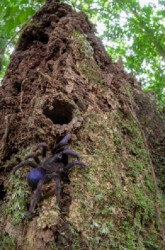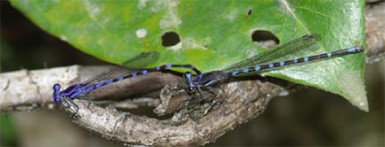A World Wildlife Fund (WWF) expedition to the Upper Potaro region earlier this year has uncovered over a dozen species possibly new to science and researchers have warned that mining activities could pose risks to the biodiversity of the region.
As many as 19 species recorded during the expedition including dragonflies, fishes, aquatic beetles and a tarantula are likely to be new to science, researchers said presenting their preliminary findings at Moray House, Camp Street yesterday. The WWF initiated and coordinated the expedition which was done in March and covered areas in the Upper Potaro and the Kaieteur National Park (KNP).
The expedition sought to establish baseline biodiversity data for the mid and highlands areas in the Kaieteur plateau to inform decision making for sustainable land use planning in the region. Over 500 species, including more than a dozen that are likely new to science were identified. Lab analysis is currently being conducted to confirm these findings.
A statement from the WWF said that aside from pockets of mining and the associated impacts on aquatic ecosystems and wildlife targeted for bush meat, the Upper Potaro region is relatively intact and healthy.
Over 500 species were identified during the assessment with more than 25 of them being endemic to the area. Endemic animals are at risk of extinction because they are only found within a specific area.


WWF Biodiversity officer Aiesha Williams said that of the probable new species, 13 include aquatic beetles while about 3 to 4 of them are fish. Further research is needed to determine whether the species are indeed new to science or are just variations of existing species, she emphasised.
Besides the new species, 18 globally-threatened species were also identified. Williams stressed the need for additional surveys to fully understand these animals and the impacts that activities such as mining can have on them. She pointed out the importance of these animals, including for the maintenance of the ecosystem and as bio-indicators of water quality.
During the expedition, tests on water quality were conducted and it was discovered that while some areas showed low turbidity (cloudiness or haziness of the water), others showed much higher levels. “The water bodies we studied show little disturbance generally,” Williams said. “There were some areas that showed high turbidity. I think one or two areas showed high turbidity and we can say for sure that they were just below where mining occurred. So the mining occurring upstream may have been the reason for high turbidity for instance and the other parameters,” she added.
Charles Hutchinson, who heads the Protected Areas/REDD+ programme at the WWF said that the areas are “largely healthy” but noted that there were exceptions in localized mining areas. He also pointed to disturbances in the ecosystem due to human activities such as mining and hunting.
Patrick Williams, Country Manager for WWF, said that a main area of concern for biodiversity conservation is gold mining. “We believe that we need to consider mining and other activities that have an impact on the environment,” he said. “We will continue to work with our partners…to ensure that we find some ways of producing good mining results. We’ll also work on finding ways to mitigate so many of the effects of mining.”
Minister of Natural Re-sources and the Environ-ment Robert Persaud said that the ministry has recognized over the years that the KNP could be threatened if not properly managed. Noting that the park is a part of the larger Potaro ecosystem, Persaud said that the KNP cannot be managed in isolation. “Reference was made to the fact in terms of turbidity and the impact on the aquatic system as a result of mining,” he said, adding that though he recognized the challenges faced, he rejected attempts to vilify mining activities done in accordance to national laws and regulations.
“Rather we should reach out, what we seek to do in the ministry, how is it we can ensure that mining activities and other activities will not have negative downstream effects on the communities and tourism activities and as well the integrity of the park as a whole,” he said. “It is constantly pursuing, and working and finding this balance which we’ve made a priority that led us to take this approach of interaction,” Persaud asserted.
The minister also took the opportunity to speak about the great potential the KNP, which includes the famous Kaieteur Falls, has in relation to tourism. He said that there were about 7000 visitors to the park last year.
The ministry, Persaud said, is currently working in collaboration with the German government on a guesthouse to accommodate overnight visitors to the park. He also said that plans are underway for a Tourism Development Strategy in partnership with the WWF and the Guyana Tourism Authority along with the Ministry of Tourism. “Having the Authority and those involved in the tourism sector is also crucial if we’re going to not only manage the park better but also develop its tourism potential,” he emphasized.
The findings of two assessments conducted in the KNP from 2011-2013 were also launched yesterday. The final report on this year’s expedition will be out by mid-2015, Hutchinson said.




